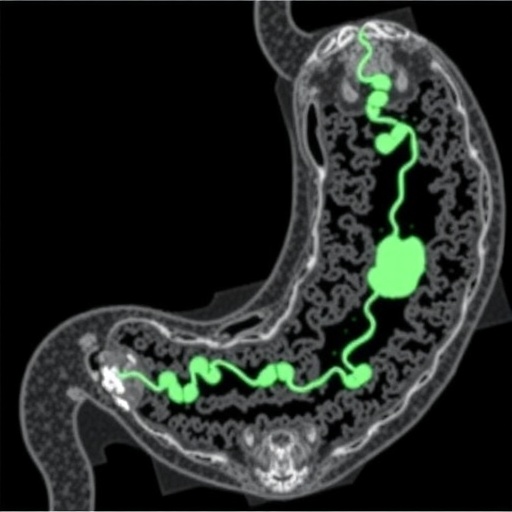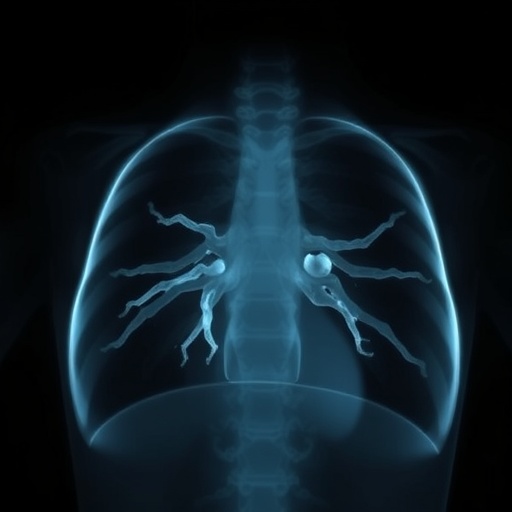In the relentless pursuit of understanding the molecular intricacies of gastric cancer, a groundbreaking correction has recently emerged that revisits and strengthens the framework of biomarker identification—specifically highlighting the role of a small RNA molecule designated as tRF-29-79MP9P9NH525. This emerging subclass of non-coding RNAs, known as transfer RNA-derived fragments (tRFs), has surged to the forefront of cancer biology due to their multifaceted regulatory functions. The corrected study elaborates compelling evidence positioning tRF-29-79MP9P9NH525 not simply as a biomarker but as a functional tumor suppressor intricately modulating the KIF14/AKT signaling axis, a pathway notorious for its oncogenic prowess within gastric carcinoma.
This correction, published in the prestigious journal Cell Death Discovery, reinforces the initial groundbreaking assertion that tRF-29-79MP9P9NH525 can act as a molecular sentinel, detecting and tempering malignant progression. Gastric cancer, ranked among the most lethal malignancies worldwide, presents an urgent demand for precise and reliable biomarkers. Traditional protein-coding gene markers have suffered limitations in sensitivity and specificity. Thus, the emergence of tRFs introduces an entirely novel paradigm, expanding the non-coding RNA universe and offering exquisite cellular regulatory potential.
At the molecular level, the nuanced interaction between tRF-29-79MP9P9NH525 and the KIF14/AKT pathway unravels a sophisticated regulatory network that tempers cellular proliferation and survival mechanisms. KIF14, a kinesin family motor protein, is implicated in cytokinesis and chromosome segregation, processes often deregulated in cancers, while AKT, a well-known serine/threonine kinase, acts as a central node in prosurvival signaling. The study elucidates how tRF-29-79MP9P9NH525 downregulates KIF14 expression, consequently dampening AKT phosphorylation states that are essential for oncogenic signaling.
.adsslot_WbfGOsqMX7{ width:728px !important; height:90px !important; }
@media (max-width:1199px) { .adsslot_WbfGOsqMX7{ width:468px !important; height:60px !important; } }
@media (max-width:767px) { .adsslot_WbfGOsqMX7{ width:320px !important; height:50px !important; } }
ADVERTISEMENT
Recent technological advancements, such as RNA sequencing and crosslinking immunoprecipitation, have been central to uncovering the dynamic landscape of tRFs. This correction clarifies earlier data points, providing refined quantification of tRF-29-79MP9P9NH525 expression profiles across gastric cancer cell lines and patient-derived samples. Notably, the corrected data underscore a robust inverse correlation between tRF expression and tumor stage, supporting the concept of tRF-29-79MP9P9NH525 as a potent tumor suppressor intrinsically linked with clinical outcomes.
The implications of these findings extend beyond diagnostics into therapeutic strategies. By harnessing the tumor-suppressing potential of tRF-29-79MP9P9NH525, novel RNA-based therapeutics could be engineered to restore or mimic its activity within the tumor microenvironment. Such precision medicine approaches could synergize with existing treatments, potentially overcoming resistance mechanisms often encountered in gastric cancer therapeutics. The corrected data invigorate hope for employing tRF-focused interventions, marking a significant leap in RNA therapeutics.
In addition to biological significance, the correction emphasizes the technical rigor involved in validating tRF-mediated pathways. The use of CRISPR-Cas9 gene editing to manipulate tRF-29-79MP9P9NH525 expression, coupled with phosphoproteomic profiling, validates causality over correlation. This methodological sophistication strengthens the impact and reproducibility of the study’s conclusions, setting a new benchmark in non-coding RNA research within oncology.
The corrected findings also bring to light the potential use of tRF-29-79MP9P9NH525 as an early detection biomarker. The study illustrates that serum levels of this tRF can be quantifiably measured through liquid biopsy platforms, offering a minimally invasive means to assess gastric cancer progression. Such early diagnostic tools are critical to improving patient survival rates by enabling timely interventions before the disease advances to metastatic or drug-resistant stages.
An intriguing aspect disclosed in the correction pertains to the evolutionary conservation of tRF-29-79MP9P9NH525 sequences across mammalian species, suggesting a fundamental and possibly ancient role in maintaining cellular homeostasis. This evolutionary perspective provides an additional layer of understanding, revealing how such small RNA fragments have been co-opted through natural selection to regulate vital cellular processes including proliferation, apoptosis, and stress responses—processes often dysregulated in cancer.
Furthermore, the correction highlights collaborative endeavors integrating multi-omics datasets. By combining genomics, transcriptomics, and proteomics analyses, the researchers paint an all-encompassing picture of the molecular interplay modulated by tRF-29-79MP9P9NH525. These integrative approaches are essential to decode the complex biological networks involved in tumor suppression, and to identify novel intervention points that could be exploited therapeutically.
Despite the promising advances, this correction calls for further exploration into the biogenesis pathways of tRF-29-79MP9P9NH525 within gastric epithelial cells and the tumor microenvironment. Elucidating the enzymatic machineries responsible for its generation, stability, and degradation can illuminate additional regulatory checkpoints, and potentially reveal targets for modulating its levels in cancerous tissues.
Another dimension broached by the correction is the potential cross-talk between tRF-29-79MP9P9NH525 and other non-coding RNA species such as microRNAs and long non-coding RNAs, forming expansive regulatory networks that orchestrate gene expression programs. Deciphering such networks is crucial to understanding the systems-level regulation driving tumor suppression and cancer progression.
Clinically, the correction reiterates the challenges of translating tRF-based findings into routine practice, emphasizing the need for comprehensive clinical trials to authenticate biomarker utility and therapeutic efficacy. Patient stratification based on tRF-29-79MP9P9NH525 expression levels could refine treatment regimens, paving the way for personalized medicine in gastric cancer care.
In summary, this pivotal correction not only reinforces the critical role of tRF-29-79MP9P9NH525 as both a biomarker and tumor suppressor but also advances the broader field of RNA biology by illuminating novel mechanistic pathways governing gastric cancer progression. It spotlights the transformative potential of tRFs in oncological research and clinical practice, signaling a paradigm shift that may revolutionize early detection, prognostication, and targeted therapies in oncology.
As scientific inquiry continues to unravel the complexities of cancer biology, the emergence of small non-coding RNAs such as tRF-29-79MP9P9NH525 exemplifies the exciting nexus between molecular innovation and clinical impact. This correction stands as a testament to the dynamic nature of research—where refinement and rigor propel us closer to defeating one of humanity’s most formidable diseases.
Subject of Research: Identification of tRF-29-79MP9P9NH525 as a biomarker and tumor suppressor in gastric cancer through its regulation of the KIF14/AKT pathway.
Article Title: Correction to: Identification of tRF-29-79MP9P9NH525 as a biomarker and tumor suppressor of gastric cancer via regulating KIF14/AKT pathway.
Article References:
Ge, J., Dai, J., Ji, H. et al. Correction to: Identification of tRF-29-79MP9P9NH525 as a biomarker and tumor suppressor of gastric cancer via regulating KIF14/AKT pathway. Cell Death Discov. 11, 353 (2025). https://doi.org/10.1038/s41420-025-02614-6
Image Credits: AI Generated
Tags: biomarker identification in cancercancer biology advancementscellular proliferation and survivalgastric cancer tumor suppressorKIF14/AKT signaling axismolecular mechanisms of gastric carcinomanon-coding RNA biomarkernovel cancer therapeutic targetsprecision medicine in oncologyregulatory functions of tRFstransfer RNA-derived fragmentstRF-29-79MP9P9NH525





